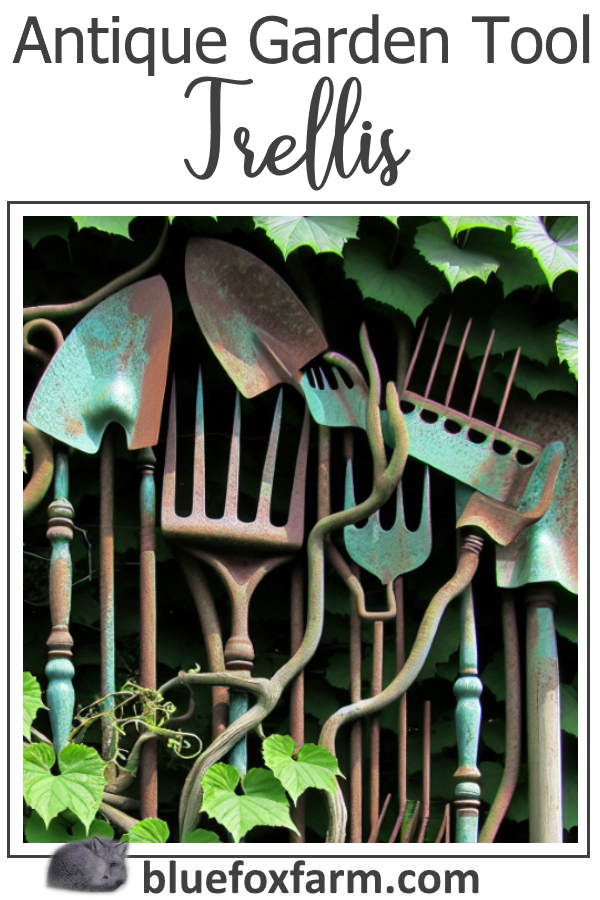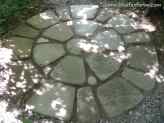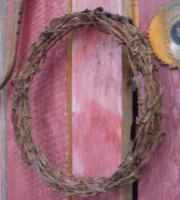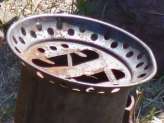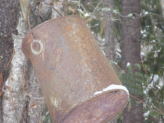Antique Garden Tool Trellis
Repurpose Your Carefully Curated Collection
Here's a guide on creating an antique garden tool trellis repurposing vintage tools that I'm sure you've been hoarding in your garden shed for exactly this kind of project - here's your sign to dig them out (see what I did there?):
Getting Started: Choosing Your Tools for Your Antique Garden Tool Trellis
The best antique tools for trellises are those with multiple tines,
prongs, or an open framework that vines can weave through. Look for:
- Old wooden-handled rakes (leaf rakes or garden rakes)
- Pitchforks and hay forks
- Cultivators and hoes with interesting shapes
- Vintage garden forks
The more weathered and rustic, the better! Flea markets, estate sales, barn auctions, and antique shops are great sources. Don't worry about broken handles or rust—these imperfections add to the primitive charm.
Installation Methods
Freestanding Style:
Drive the tool handle directly into the
soil, making sure it's deep enough (at least 12-18 inches) to remain
stable as plants grow and add weight. For extra stability, you can:
- Add a wooden stake behind the handle and wire them together
- Pour a small amount of concrete around the base
- Anchor it to a T-post hidden behind the tool
Leaning
Style:
Prop tools at an angle against a fence, wall, or shed. Secure the top with wire, hooks, or twine to prevent slipping. This method works beautifully for creating a rustic backdrop along garden beds.
Mounted Style:
Attach tools flat against a wall or fence using screws through the handle or wire wrapped around the metal head. This creates a vertical growing surface perfect for smaller spaces.
Best Plants for Tool Trellises
Annual Vines:
- Morning glories (easy and fast-growing)
- Sweet peas (fragrant and delicate)
- Scarlet runner beans (edible and ornamental)
- Black-eyed Susan vine
- Nasturtiums (trailing varieties)
Perennial Vines:
- Clematis (various colors and bloom times)
- Climbing roses (for larger, sturdier tools)
- Honeysuckle
- Trumpet vine (vigorous grower)
Edible Climbers:
- Pole beans
- Peas (snap, snow, or shell varieties)
- Small cucumber varieties
- Smaller squash or gourds
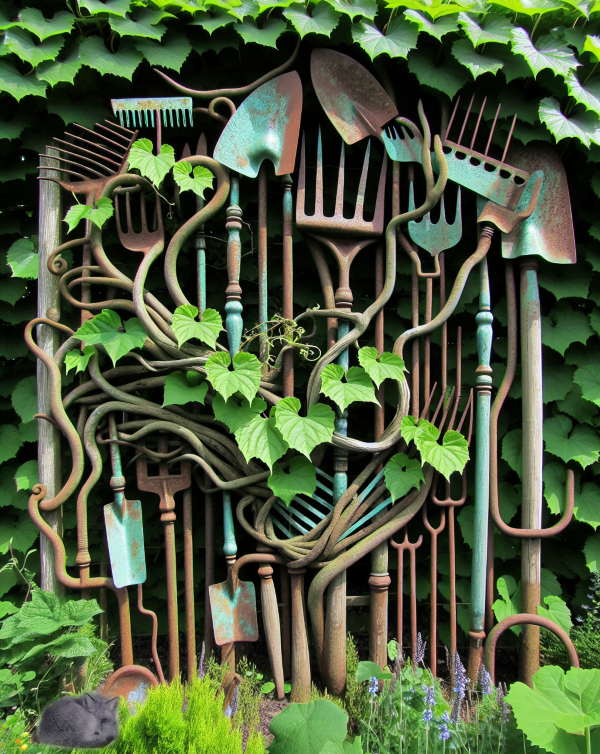 Make a simple Antique Garden Tool Trellis for an amazing way to display your collection of old tools
Make a simple Antique Garden Tool Trellis for an amazing way to display your collection of old toolsDesign Ideas and Arrangements
Single Statement Piece:
Use one large, impressive tool like a pitchfork as a standalone trellis in a container or garden bed. Plant colorful morning glories or sweet peas at its base for a simple but striking focal point.
Tool Trellis Row:
Line up several matching or complementary tools along a garden path or vegetable bed. Space them 2-3 feet apart and plant different climbing varieties at each one for a cottage garden effect.
Crossed Tools Tepee:
Gather 3-4 long-handled tools (rakes, hoes, or forks) and tie their handles together at the top, spreading the bottoms out to form a tepee shape. This creates a sturdy structure for heavier vines and makes a wonderful garden focal point.
Layered Wall Display:
Mount multiple tools at different heights on a fence or wall, creating a living tapestry as vines climb and weave between them. Mix tool types for varied textures and visual interest.
Use some rusty fence panels as a base, and tie or wire the tools to that, and attach it to a fence or shed. Make sure the attachment is strong and secure. Nothing takes the fun out of it quicker than having to redo the entire structure when it falls down.
Styling Tips for Primitive Charm
- Leave the natural patina and rust intact—it adds authenticity
- Wrap jute twine or rusty wire around handles for extra primitive detail
- Combine with other primitive elements like galvanized buckets at the base or weathered wooden signs
- Plant in old wooden crates, whiskey barrels, or galvanized tubs for a cohesive look
- Add a vintage straw hat or work gloves draped over a tool handle for extra character
Maintenance and Care
- Check stability throughout the growing season, especially after heavy rains or winds
- Guide vines onto the tool as they grow, gently weaving tendrils through tines
-
If tools are very rusty, you can seal them with a clear matte spray to
prevent rust from staining plants or transferring to hands
- At
season's end, cut away annual vines and store delicate antique tools
indoors if desired, or leave them in place year-round for continued
garden interest
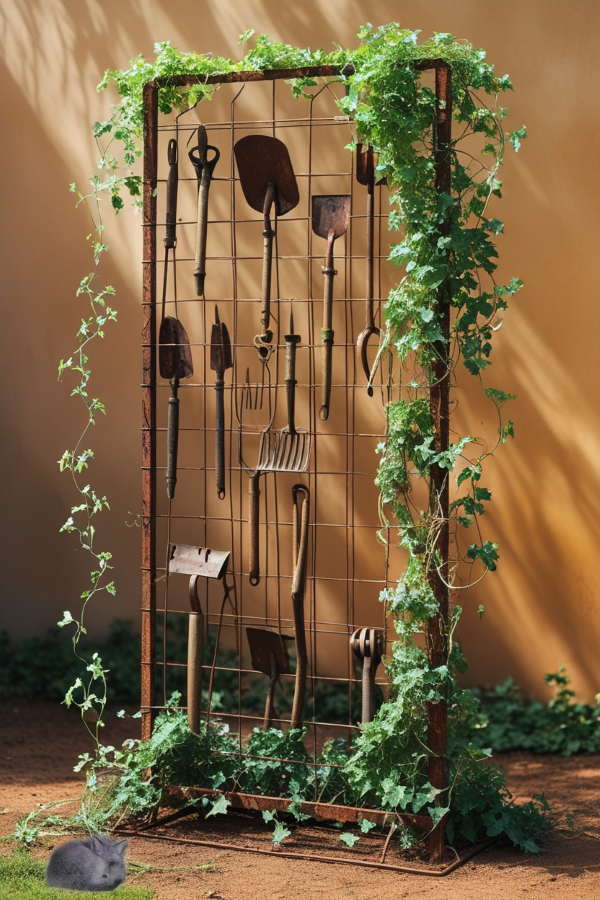 Wired onto a piece of rusty fence, or even a bed frame as a back ground, your antique tools will have a new life as a trellis
Wired onto a piece of rusty fence, or even a bed frame as a back ground, your antique tools will have a new life as a trellisSeasonal Variations
Spring/Summer:
Focus on flowering vines and lush greenery
Fall:
Plant ornamental gourds or small pumpkins that can climb and drape
Winter:
Leave the bare tools in place as sculptural garden art, perhaps with dried vines or evergreen garland wrapped around them for seasonal interest
This repurposed garden tool trellis project perfectly combines functionality with primitive country charm, turning forgotten farm implements into beautiful, working garden features that honor traditional gardening heritage.
I hope you've got some inspiration and motivation to dig out all those vintage garden tools, and make them into something very unique and individual.
Learn what it takes to be creative - we all have the gene but how do we develop it? Get the free guide!
Fill in the form below for your copy;
(Don't be disappointed - use an email address that will accept the free download - some .aol email addresses won't.
If you don't see your download within a few minutes, try again with another email address - sorry for the bother.)
